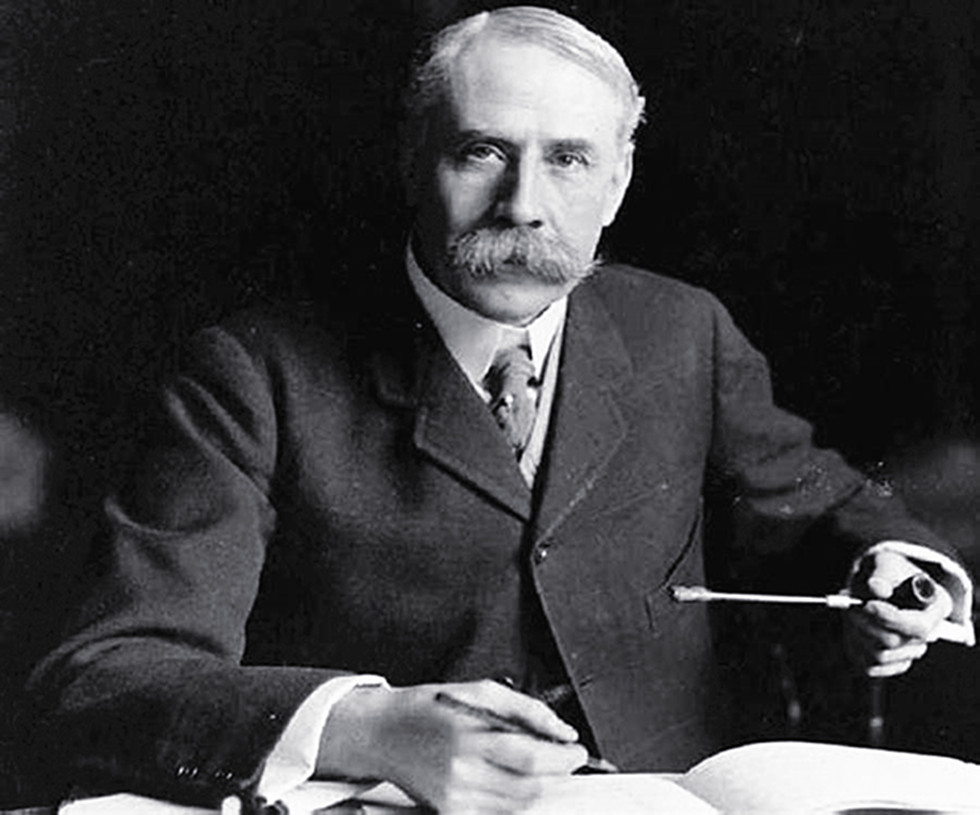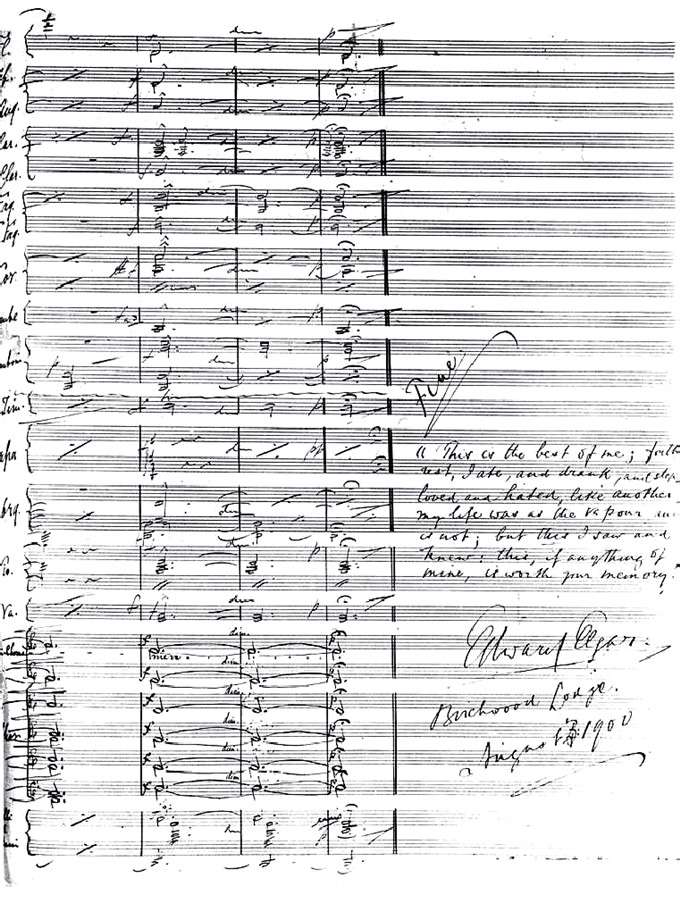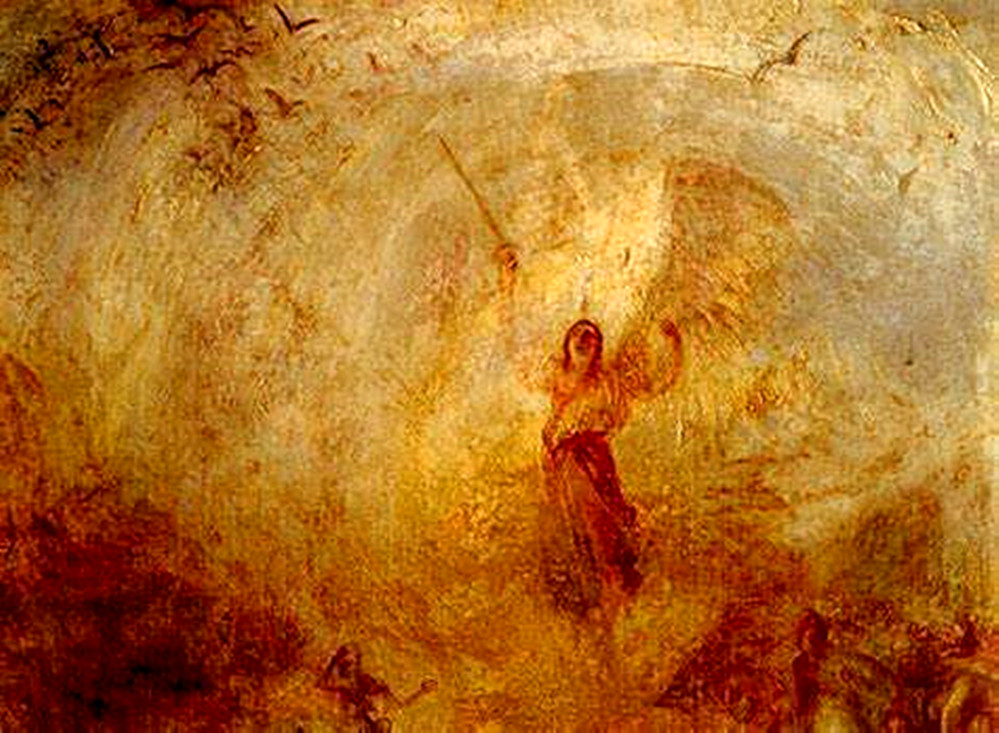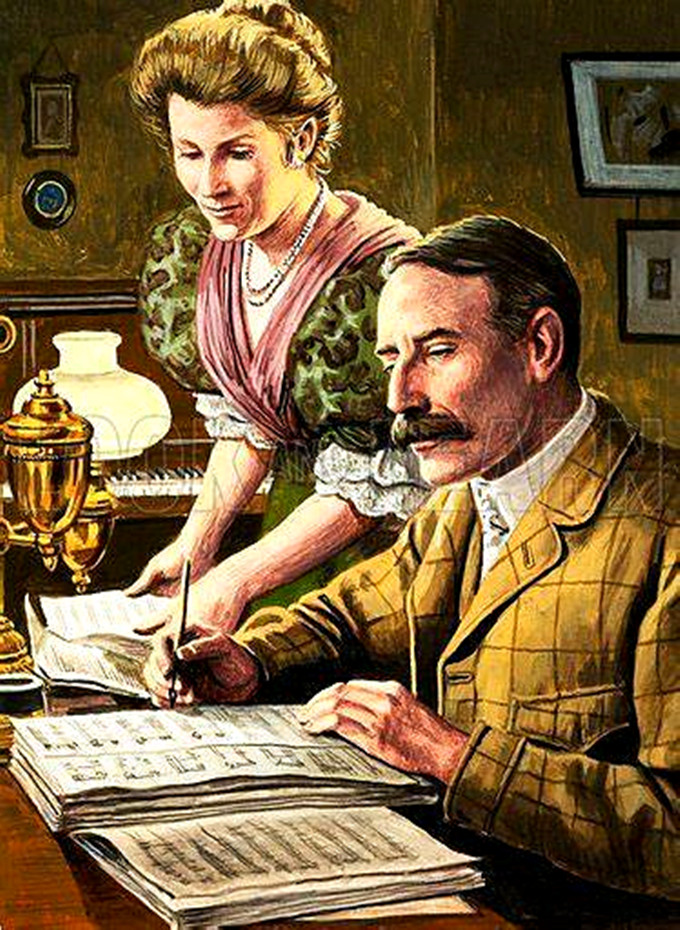| |
|
|
|
|
|
|
|
|
|
|
| |
| |
 |
|
| |
田润德 编译
文/图 2020-10-02 19:36 |
|
| |
|
|
|
|
| |
 |
|
|
|
| |
爱德华·埃尔加(Edward Elgar
1857—1934) |
|
|
|
| |
|
|
| |
丹尼尔·哈丁指挥瑞典广播交响乐团 - 埃尔加:杰隆修斯之梦
|
|
|
|
| |
(Edward Elgar: The Dream of
Gerontius, Op. 38) |
|
|
|
| |
与韩德尔的《弥赛亚》和英国的《战争安魂曲》一样,埃尔加的《格隆休斯的梦》是英国最重要的音乐作品之一。这部由最近被神化的英国神学家和诗人约翰·亨利·纽曼撰写的强有力的文本讲述了一个垂死的人,他的生命行为正在上帝面前被调查。在音乐中,埃尔加以一种动人的方式将英国的优雅与瓦格纳的细节相结合。
安哈伦贝格女中音
安德鲁•斯台普斯男高音
西蒙爵士,男中音
米凯利室合唱团
圣雅各布斯合唱团
瑞典广播交响乐团和广播合唱团
山姆·埃文斯唱诗班指挥
丹尼尔·哈丁,指挥 |
|
|
|
| |
Together with Handel's Messiah and Britain's War Requiem
, Elgar's Gerontius's dream is one of the most important British musical
works written. The strong text, written by the recently sanctified
English theologian and poet John Henry Newman, tells of a dying man
whose life's actions are being investigated before God. Elgar in the
music combines British elegance with Wagnerian detail in a touching way.
Ann Hallenberg, mezzo-soprano
Andrew Staples, tenor
Sir Simon Keenlyside, baritone
Mikaeli Chamber Choir
St. Jacobs Vocal Ensemble
Swedish Radio Symphony Orchestra & Radio choir
Sam Evans, choirmaster
Daniel Harding, chief conductor |
|
|
|
| |
|
|
|
|
| |
音乐历史上的今天
1900年10月3日
《杰隆修斯之梦》在伯明翰噩梦般的首演让 43岁的
作曲家爱德华·埃尔加说出亵渎神灵的话语:“我一直说上帝与艺术作对……我曾经试图敞开心灵——现在它将永远把宗教情感关在门外,以及将来每一次温柔的冲动。”
爱德华·埃尔加(Edward
Elgar,1857年-1934年),英国作曲家、指挥家,1857年6月2日在伍斯特郡莫尔文希尔斯区布罗德希思出生。他父亲是一个乐器店店主兼圣乔治教堂管风琴乐手。埃尔加成长在浓厚的音乐环境中。但主要靠自学,15岁的时候他想去德国莱比锡留学学习音乐,但是由于经费不够,只好在他父亲的商店工作,并参加了社区的一个音乐俱乐部,在乐队里当小提琴乐手。1885年继承父职任教堂管风琴师。在他29岁的时候,他认识了大他8岁的前市长亨利·罗伯兹爵士的女儿爱丽丝,3年之后两人结婚。在妻子的鼓励和疏通下,埃尔加集中精力进行音乐创作,1890年,以序曲《弗鲁瓦萨尔》引起人们的注意。并搬到伦敦发展,进入音乐圈子。但是初期并不成功。不久因为健康原因又返回家乡。
直到埃尔加将近40岁的时候,他才有了一些作曲家的名气。他为地方音乐节谱写音乐,并逐渐被人重视。1899年在他42岁的时候,他的第一部交响乐作品《谜语变奏曲》获得出版,并在伦敦由德国指挥家Hans
Richter指挥首演,获得成功。1900年他又创作了清唱剧《杰龙修斯之梦》(根据红衣主教约翰·亨利·纽曼的诗词谱曲)。这两部作品被誉为英国音乐开始复兴的标志。1901年他创作了他的5首《威仪堂堂进行曲》的第一首(最后一首创作于1930年),好评如潮,英国国王和王后也出席他的音乐会。这奠定了他作为当时英国最成功作曲家的声誉。此后他又写了序曲《在伦敦城中》(1901)、清唱剧《基督使徒》(1903)和《王国》(1906)等一系列作品。1902年到1914年之间,他四次访问美国。1904年他获得爵士称号。1905年到1908年他在伯明翰大学任教。1908年他的《第一交响曲》一年之内演出了一百场。1911年他的《第二交响曲》上演,同年他获得功绩勋章,此后专注于大型器乐曲的创作。如
《小提琴协奏曲》(1910)、交响练习曲《福斯塔夫》(1913)、《大提琴协奏曲》(1919)等。1912年他又搬到伦敦居住。1920年后,由于妻子去世,很少有重要创作。1924年被封为英王御前音乐教师。1931年成为从男爵。1934年2月23日卒于伍斯特。
今日视频:1、丹尼尔·哈丁指挥瑞典广播交响乐团y演奏埃尔加的清唱剧《杰隆修斯之梦》; 2、埃尔加谜语变奏曲。 |
|
|
|
| |
 |
|
| |
爱德华·埃尔加(Edward
Elgar,1857年-1934年),英国作曲家、指挥家,1857年6月2日在伍斯特郡莫尔文希尔斯区布罗德希思出生。 |
|
|
|
| |
Edward Elgar (1857 -
1934), a British composer and conductor, was born on June 2, 1857 in
Broadhuse, Morwen Hills, Worcestershire. |
|
|
|
| |
埃尔加的清唱剧《杰隆修斯之梦》 |
|
|
|
| |
埃尔加(Edward
Elgar,1857-1934)是19世纪末20世纪初英国著名作曲家。其作品风格大体属于晚期浪漫派,有多部器乐,声乐作品传世。清唱剧《杰隆修斯之梦》是埃尔加最著名的声乐作品之一。
这部清唱剧以神学家兼诗人约翰·亨利·纽曼(John Henry
Newman,1801-1890)的一首同名长诗为歌词。纽曼是英格兰人,原在英国国教任职;后皈依罗马天主教,并逐渐成为一名红衣主教。其长诗是用英语写成。作品表达了一个叫杰隆修斯的人在临终时进入梦境,梦见其灵魂远行,碰到了天使,也遇到了魔鬼。当他面临最后的审判时,他是带着得救的希望离开的。原诗发表于1865年,并受到好评。
埃尔加的这部清唱剧是为一位男高音,一位女中音,一或两位男低音独唱,两个合唱队和一个大型管弦乐队而作。由男高音演唱杰隆修斯,女中音演唱天使,男低音演唱神父及另一位痛苦的天使。尽管作曲家本人并不喜欢“清唱剧”这个标签,但后世根据作品的总特点,还是把她归为清唱剧。作品于1900年在伯明翰市政厅首演,以后逐渐成为二十世纪经典的合唱作品之一。
作品由下列两大部分共十三个分段组成:
第一部分(Part I):
1. 序曲(Prelude);
2. 耶稣,玛丽亚 – 我快要死了(Jesu, Maria – I am near to death);
3. 唤醒你,我那昏厥的灵魂(Rouse thee, my fainting soul);
4. 神圣强大的神(Sanctus fortis, sanctus Deus);
5. 开始基督徒的生活(Proficiscere, anima Christiana);
第二部分(Part II):
1. 我去睡了(I went to sleep);
2. 那个家族的一个成员(It is a member of that family);
3. 但是你听!我感到激烈的喧嚣(But hark! upon my sense comes a fierce hubbub);
4. 我看到的不是那些假精灵(I see not those false spirits);
5. 但是你听!盛大而神秘的和谐(But hark! a grand mysterious harmony);
6. 你的审判正在临近(Thy judgment now is near);
7. 我要在审判之前走(I go before my judge);
8. 轻轻而明确地赎回的灵魂(Softly and gently, dearly-ransomed soul)。
与通常的清唱剧不同的是,两大部分之内的分段之间没有明显的休止。全曲用时约95分钟。
这部清唱剧的主角无疑是男高音演唱的杰隆修斯,他的唱段很多,并充满了戏剧性的变化和起伏,表达了主人公内心的矛盾,痛苦,及最后的解脱。而女中音和男低音分别演唱的天使和神父像是重要的配角,他们和主角之间有不同的呼应及对唱,重唱等。合唱队更多是配合几位独唱,营造并烘托相应情节和气氛。
在我们这个“合唱经典”的系列里,前面已经欣赏了不同历史时期的多部清唱剧,都是宗教题材,包括巴洛克时期巴赫的《圣诞节》,亨德尔的《弥赛亚》;古典主义时期海顿的《创世纪》;以及浪漫主义早期门德尔松的《以利亚》。这次欣赏的埃尔加的《杰隆修斯之梦》与前面欣赏过的这些清唱剧最明显的不同是其晚期浪漫派的音乐风格,简单概括地说,就是感情表达更为强烈,夸张;音乐的强弱起伏更大;速度的变化更多;调性的变化更频繁;和声的“色彩”更丰富,等等。当然这些都是超级概括,实际作品的细节是丰富多彩,变化万千的,需要仔细聆听,仔细感受。
|
|
|
|
| |
 |
|
|
|
| |
埃尔加的清唱剧《杰隆修斯之梦》总谱手稿 |
|
|
|
| |
First page manuscript of the
score of Elgar's cantata The Dream of Gerontius |
|
|
|
| |
Introduction to
the oratorio "The Dream of Gerontius" by Edward Elgar (1857-1934): Edward
Elgar was a renowned British composer in the late 19th and early 20th
centuries. His works generally fall under the category of late
Romanticism, and he left behind several instrumental and vocal
compositions. The oratorio "The Dream of Gerontius" is one of Elgar's
most famous vocal works. This oratorio is based on a long poem of the
same name by the theologian and poet John Henry Newman (1801-1890).
Newman was an Englishman who originally held a position in the Church of
England; later he converted to Roman Catholicism and gradually became a
cardinal. The poem was written in English. The work expresses that a
person named Jeronius entered a dream at the end of his life, dreaming
that his soul traveled far away, met angels, and also encountered the
devil. When he faced the final judgment, he left with the hope of
salvation. The original poem was published in 1865 and received
favorable reviews. Elgar's oratorio was composed for a tenor, a
mezzo-soprano, one or two basses soloists, two choirs, and a large
orchestra. The tenor sang Jeronius, the mezzo-soprano sang the angel,
and the basses sang the priest and another suffering angel. Although the
composer himself did not like the label "oratorio", later generations
classified it as an oratorio based on the overall characteristics of the
work. The oratorio premiered at the Birmingham Town Hall in 1900 and
gradually became one of the classic choral works of the 20th century.
The work consists of the following two parts with thirteen sections in
total: Part I: 1. Prelude; 2. Jesus, Maria – I am near to death; 3.
Rouse thee, my fainting soul; 4. Sanctus fortis, sanctus Deus; 5.
Proficiscere, anima Christiana; Part II: 1. I went to sleep; 2. It is a
member of that family; 3. But listen! I feel a fierce hubbub upon my
senses; 4. What I see is not those false spirits; 5. But listen! A grand
mysterious harmony; 6. Thy judgment now is near; 7. I go before my
judge; 8. Softly and gently, dearly-ransomed soul. Unlike typical
oratorios, there is no obvious pause between the sections within the two
parts. The entire work lasts approximately 95 minutes. The protagonist
of this oratorio is undoubtedly the tenor singer, Jeronimus. His singing
parts are numerous and full of dramatic changes and fluctuations,
expressing the inner conflicts, pain, and eventual liberation of the
protagonist. The soprano and bass singers who sing the roles of the
angel and the priest are like important supporting characters. They have
different echoes, duets, and choruses with the protagonist. The choir
mainly cooperates with the soloists to create and enhance the
corresponding plot and atmosphere. In our "Choral Classics" series, we
have already appreciated many oratorios from different historical
periods, all of which are religious-themed, including Bach's "Christmas"
in the Baroque period, Handel's "Messiah", Haydn's "Creation" in the
Classical period, and Mendelssohn's "Elijah" in the early Romantic
period. The most obvious difference between this performance of Elgar's
"Gerontius' Dream" and the previous oratorios we have appreciated is its
late Romantic musical style. In a nutshell, it is characterized by more
intense and exaggerated emotional expression; greater fluctuations in
the strength and tempo of the music; more changes in speed; more
frequent changes in key; and richer "color" of harmony. Of course, these
are very general summaries. The actual works have rich and varied
details, and require careful listening and careful appreciation. |
|
|
|
| |
 |
|
| |
埃尔加的清唱剧《杰隆修斯之梦》的海报。 |
|
|
|
| |
The poster of Elgar's
oratorio "The Dream of Gerontius". |
|
|
|
| |
 |
|
|
|
| |
Edward Elgar: A
Thematic Catalogue and Research Guide (2nd Edition)
爱德华·埃尔加和他妻子卡罗琳·爱丽丝·埃尔加的照片,据信是1891年左右拍摄的。摄影师不详 |
|
|
|
| |
Photograph of Edward
Elgar and his wife Caroline Alice Elgar believed to date from c.
1891. Photographer unknown |
|
|
|
| |
 |
|
|
|
| |
爱德华·埃尔加和他妻子卡罗琳·爱丽丝·埃尔加。 |
|
|
|
| |
Edward Elgar and his wife
Caroline Alice Elgar |
|
|
|
| |
 |
|
|
|
| |
埃尔加在潜心研究写作清唱剧《杰隆修斯之梦》,独唱、合唱团与管弦乐队的清唱剧,作品38号。 |
|
|
|
| |
Elgar was concentrating on
writing the oratorio "The Dream of Gerontius", a solo, chorus and
orchestra oratorio, work number 38. |
|
|
|
| |
埃尔加首演失败的d《吉隆修斯之梦》 |
|
|
|
| |
埃尔加的清唱剧《吉隆修斯之梦》完成于1900年8月13日了,埃尔加f非常珍视它,这一天写道“这是我最美好的一面;至于其他,我吃饭、喝水、睡觉、恋爱、憎恨、同别人一样;我的生活曾经像蒸汽,而现在不同了。但是‘这个’,我看见并且了解;若我有什么值得你们怀念,便是这个。” |
|
|
|
| |
 |
|
|
|
| |
埃尔加的《吉隆修斯之梦》手稿 |
|
|
|
| |
Elgar's manuscript of "The
Dream of Gerontius" |
|
|
|
| |
Elgar's oratorio
"The Dream of Gerontius" was completed on August 13, 1900. Elgar
cherished it very much. On this day, he wrote, "This is my most
beautiful aspect; as for the rest, I eat, drink, sleep, fall in love,
hate, just like everyone else; my life was like steam before, but now
it's different. But 'this', I see and understand it; if there is
anything worth remembering for you, it is this." |
|
|
|
| |
爱德华·埃尔加的《吉隆修斯之梦》(作品38号),取材自约翰·亨利·纽曼的诗作。这部作品以清唱剧形式,讲述了一位虔诚男子从临终病榻到接受上帝审判、最终在炼狱中安息的灵魂之旅。尽管埃尔加本人反对使用“清唱剧”这个称谓,但观众们却觉得它就是一部标准的清唱剧。这首作品是为1900年伯明翰音乐节创作的,首演于同年10月3日在伯明翰市政厅举行。首演时遭到冷遇,如今却在英德两国广为流传。首演后的十年间,纽曼的天主教信仰曾阻止《吉隆修斯之梦》进入英国圣公会教堂,不过现在一切都已恢复正常! |
|
|
|
| |
O
Sonho de Gerontius, Op. 38, é um trabalho para vozes e orquestra em duas
partes composto por Edward Elgar em 1900, sobre poema de John Henry
Newman. Ele narra a jornada da alma de um homem piedoso de seu leito de
morte até seu julgamento diante de Deus, se estabelecendo no Purgatório.
Elgar desaprovou o uso do termo “oratório”, mas a gente acha que é e
pronto. O trabalho foi composto para o Birmingham Music Festival de
1900; a primeira apresentação ocorreu em 3 de outubro de 1900, na
prefeitura de Birmingham. Foi detestado na estreia, mas hoje é muito
executado na Inglaterra e na Alemanha. Na primeira década após sua
estreia, o catolicismo de Newman impediu que Gerontius entrasse nas
catedrais anglicanas, só que agora tudo bem. |
|
|
|
| |
 |
|
| |
埃尔加的《吉隆修斯之梦》出版总谱第一页
|
|
|
|
| |
The first page of the
complete score of Elgar's "The Dream of Gyorgyos" |
|
|
|
| |
 |
|
|
|
| |
埃尔加和年轻的小提琴家梅纽因在一起 |
|
|
|
| |
Elgar was together with the
young violinist Menuhin. |
|
|
|
| |
 |
|
|
|
| |
爱德华·埃尔加爵士的指挥风采 |
|
|
|
| |
Sir Edward Elgar's conducting
style |
|
|
|
| |
|
|
|
|
| |
 |
|
|
|
| |
巴伦博伊姆指挥柏林爱乐演绎埃尔加的《吉隆修斯之梦》 |
|
|
|
| |
Barenboim conducted the
Berlin Philharmonic Orchestra to perform Elgar's "The Dream of
Gerontius". |
|
|
|
| |
 |
|
|
|
| |
埃尔加《杰隆修斯之梦》 诺顿·罗尔夫·约翰逊
凯瑟琳·温-罗格斯 米歇尔·乔治 皇家利物浦爱乐乐团 皇家利物浦爱乐合唱团 亨德斯菲尔德合唱协会 弗农·哈尼 管弦乐奏鸣曲(由戈登·雅各布编曲)
艾美·艾敏尼斯 |
|
|
|
| |
Elgar "The Dream of
Gerontius"
Norton Rolph Johnson Catherine Wynn-Rogers Michel George Royal Liverpool
Philharmonic Orchestra Royal Liverpool Philharmonic Chorus Hendesfield
Choral Society Vernon Hani String Quartet (arranged by Gordon Jacob) Amy
Eminensky |
|
|
|
| |
 |
|
|
|
| |
埃尔加《杰隆修斯之梦》o'p.38 完整版 |
|
|
|
| |
Elgar's "The Dream of
Gerontius" Complete Version |
|
|
|
| |
 |
|
|
|
| |
莱昂·波特斯坦现场版《杰隆修斯之梦》 |
|
|
|
| |
Leon Portstein Live Version
The Dream of Gerontius, Op. 38 |
|
|
|
| |
 |
|
|
|
| |
吉隆·托伊斯版 |
|
|
|
| |
Gillon Tuiso Version The
Dream of Gerontius, Op. 38 |
|
|
|
| |
 |
|
|
|
| |
西蒙·拉特尔 伯明翰市交响乐团演绎《杰隆修斯之梦》 |
|
|
|
| |
Simon Rattle, Birmingham
Symphony OrchestraThe Dream of Gerontius, Op. 38 |
|
|
|
| |
 |
|
|
|
| |
爱德华·埃尔加爵士,格兰杰拍摄 |
|
|
|
| |
Sir Edward Eogar Photograph
by Granger |
|
|
|
| |
|
|
|
|
| |
Today in the
history of music
On this day in music history, October 3, 1900, the nightmarish premiere
of "The Dream of Jeronsius" in Birmingham led 43-year-old composer
Edward Elga to utter blasphemous words: "I have always said that God is
against art..." I once tried to open my heart - now it will forever shut
out religious feelings and every gentle impulse in the future.
Edward Elgar
(1857 -1934), a British composer and conductor, was born on June 2,
1857, in Broadheath, Molvinshire, Worcestershire. His father was the
owner of an instrument store and an organist at St. George's Church.
Elga grew up in a rich musical environment. But he mainly relied on
self-study. At the age of 15, he wanted to study music in Leipzig,
Germany. However, due to insufficient funds, he had to work in his
father's store and joined a music club in the community, playing the
violin in the band. In 1885, he succeeded his father as the church
organist. When he was 29 years old, he met Alice, the daughter of Sir
Henry Roberts, the former mayor who was eight years older than him.
Three years later, they got married. Encouraged and persuaded by his
wife, Elgar focused on his musical composition. In 1890, he caught
people's attention with the overture "Frovasal". And moved to London to
develop his career, entering the music circle. But it was not successful
in the early stage. Not long after, he returned to his hometown for
health reasons.
It was not
until Elgar was nearly 40 that he gained some reputation as a composer.
He composed music for local music festivals and gradually gained
attention. In 1899, at the age of 42, his first symphonic work,
"Variations on Riddles", was published and premiered in London under the
baton of the German conductor Hans Richter, achieving great success. In
1900, he composed the oratorio "The Dream of Jeronius" (set to music
based on the poems of Cardinal John Henry Newman). These two works are
hailed as the hallmark of the beginning of the revival of British music.
In 1901, he composed the first of his five "Grand Marches" (the last one
was written in 1930), which received widespread acclaim. The King and
Queen of England also attended his concerts. This established his
reputation as the most successful composer in Britain at that time.
After that, he wrote a series of works including the overture "In the
City of London" (1901), the oratorio "The Apostles of Christ" (1903),
and "The Kingdom" (1906). Between 1902 and 1914, he visited the United
States four times. He was knighted in 1904. He taught at the University
of Birmingham from 1905 to 1908. In 1908, his First Symphony was
performed a hundred times within a year. In 1911, his Second Symphony
was staged, and in the same year he was awarded the Medal of Merit.
After that, he focused on the composition of large-scale instrumental
music. Such as "Violin Concerto" (1910), symphonic Etude "Falstaff"
(1913), "Cello Concerto" (1919), etc. In 1912, he moved to London to
live again. After 1920, due to the death of his wife, he made few
significant works. In 1924, he was appointed as a music teacher before
the King of England. He became a baronet in 1931. He died in Worcester
on February 23, 1934.
Today's video:
1. Daniel Harding conducts the Swedish Radio Symphony Orchestra y to
perform Elgar's oratorio "The Dream of Gerontius"; 2. Elgar's Riddle
Variations. |
|
|
|
| |
|
|
|
|
| |
 |
|
|
|
| |
埃尔加,爱德华爵士(1857 - 1934
年)。这幅肖像照片上署有“J.
布伦贝尔”的字样,并在照片上签名“致以最诚挚的问候,爱德华·埃尔加”。照片中埃尔加正坐着,面向前方,腿上还趴着一只狗,尺寸为
235 毫米×155 毫米。这张照片由埃德加和温妮弗雷德·沃德为“格拉莫波唱片有限公司”拍摄,拍摄于 1932 年 7 月 26
日(背面有题字),已装裱并贴上玻璃(签名略有褪色)。 |
|
|
|
| |
ELGAR, Sir Edward
(1857-1934). Portrait photograph inscribed to 'J. Burnell' and
signed 'Kindest regards Edward Elgar' on the image, the
photograph showing Elgar seated, facing forward with a dog on
his lap, 235 x 155mm, by Edgar and Winifred Ward for The
Gramophone Co. Ltd. Hayes, Middlesex, 26 July 1932 (inscribed on
verso), framed and glazed (signature slightly faded). |
|
|
|
| |
|
|
|
|
| |
|
|
| |
Elgar: Enigma Variations, Op. 36 谜语变奏曲 - 埃尔加
|
|
|
|
| |
爱德华·埃尔加:《原始主题变奏曲》(谜语变奏曲),作品36号(附乐谱)作曲时间:1898-1899年指挥:安德鲁·戴维斯乐团:BBC交响乐团00:00主题-行板01:34变奏一C.A.E.
-同速03:29变奏二H.D.S-P. -快板04:15变奏三R.B.T. -小快板05:39变奏四W.M.B.
-极快板06:09变奏五R.P.A. -中板08:24变奏六Ysobel -行板09:47变奏七Troyte
-急板10:46变奏八W.N. -小快板12:41变奏九Nimrod -柔板16:56变奏十Dorabella
-间奏曲:小快板19:28变奏十一G.R.S. -极快板20:30变奏十二B.G.N. -行板23:29变奏十三* * *
-浪漫曲:中板26:21变奏十四E.D.U. -终曲:快板
Edward Elgar:
Variations on an Original Theme (Enigma Variations), Op. 36
(with Score)
Composed: 1898 - 99
Conductor: Andrew Davis
Orchestra: BBC Symphony Orchestra
00:00 Theme - Andante
01:34 Var. I C.A.E. - L'istesso tempo
03:29 Var. II H.D.S-P. - Allegro
04:15 Var. III R.B.T. - Allegretto
05:39 Var. IV W.M.B. - Allegro di molto
06:09 Var. V R.P.A. - Moderato
08:24 Var. VI Ysobel - Andantino
09:47 Var. VII Troyte - Presto
10:46 Var. VIII W.N. - Allegretto
12:41 Var. IX Nimrod - Adagio
16:56 Var. X Dorabella - Intermezzo: Allegretto
19:28 Var. XI G.R.S. - Allegro di molto
20:30 Var. XII B.G.N. - Andante
23:29 Var. XIII * * * - Romanza: Moderato
26:21 Var. XIV E.D.U. - Finale: Allegro
At the end of an overlong day laden with teaching and other
duties, Edward Elgar lit a cigar, sat at his piano and began
idling over the keys. To amuse his wife, the composer began to
improvise a tune and played it several times, turning each
reprise into a caricature of the way one of their friends might
have played it or of their personal characteristics. "I believe
that you are doing something which has never been done before,"
exclaimed Mrs. Elgar. Thus was born one of music's great works
of original conception, and Elgar's greatest large-scale "hit":
the Enigma Variations. The enigma is twofold: each of the 14
variations refers to a friend of Elgar's, who is depicted by the
nature of the music, or by sonic imitation of laughs, vocal
inflections, or quirks, or by more abstract allusions. The other
enigma is the presence of a larger "unheard" theme which is
never stated but which according to the composer is very well
known. The identity of the phantom tune left the world with the
composer, and guesses have ranged from "God Save the King" to a
simple major scale.
在漫长的一天结束时,爱德华·埃尔加点燃雪茄,坐在钢琴前开始漫不经心地弹奏。为了逗妻子开心,这位作曲家即兴创作了一段旋律并反复演奏,每次重复都模仿朋友的演奏风格或自身特点。“我相信你正在尝试前所未有的创作方式”,埃尔加夫人惊叹道。就这样诞生了音乐史上一部极具原创性的杰作——埃尔加最著名的大型“爆款”作品《谜语变奏曲》。这个谜题包含双重含义:14个变奏各自对应一位作曲家的朋友,通过音乐特质、笑声模仿、声线变化或怪癖表现,或是更抽象的暗示来刻画他们的形象;另一个谜题则在于存在一个从未被陈述却广为人知的宏大“未闻”主题。这个幽灵般的旋律伴随作曲家离开人世,人们对其猜测不一,从《天佑国王》到简单的自然音阶都有过各种解读。
|
|
|
|
| |
未得原作者编者授权严禁转载www.mt77.com任何内容 |
|
|
|
|
|
|
|
|
|
|
|
|
|
|
.png)

